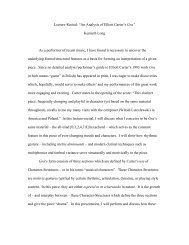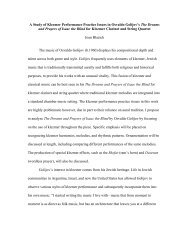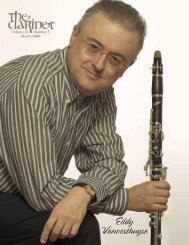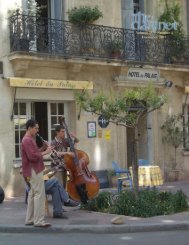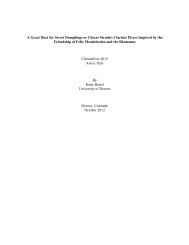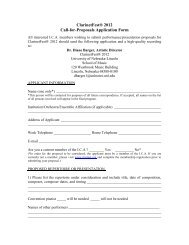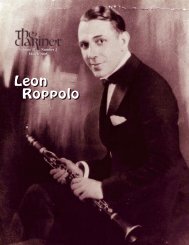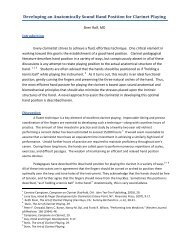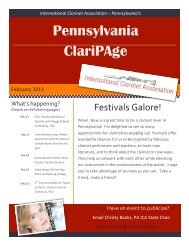Solo and Chamber Works for Clarinet by Students of Paul Hindemith
Solo and Chamber Works for Clarinet by Students of Paul Hindemith
Solo and Chamber Works for Clarinet by Students of Paul Hindemith
Create successful ePaper yourself
Turn your PDF publications into a flip-book with our unique Google optimized e-Paper software.
A Mutual Influence: <strong>Solo</strong> <strong>and</strong> <strong>Chamber</strong> <strong>Works</strong> <strong>for</strong> <strong>Clarinet</strong><strong>by</strong> <strong>Students</strong> <strong>of</strong> <strong>Paul</strong> <strong>Hindemith</strong>Laura Armstrong<strong>Paul</strong> <strong>Hindemith</strong> (1895-1963) composed many solo <strong>and</strong> chamber works <strong>for</strong> clarinet, <strong>and</strong>most are st<strong>and</strong>ard works in the clarinet repertoire. It may be interesting to clarinetists to knowthat many <strong>of</strong> his students have done the same. While most <strong>of</strong> these works are largely unknownto most clarinetists, they would greatly add to their repertoire. In this presentation I will discusssome <strong>of</strong> these works written <strong>by</strong> his students, <strong>and</strong> introduce these composers to clarinetists.While in no means does this imply that <strong>Hindemith</strong> was the only person they studied with, or thathe controlled everything they ever wrote, this will serve as a new way <strong>of</strong> looking at some morerecent music that has been written <strong>for</strong> the clarinet.<strong>Hindemith</strong> taught at the Berlin Hochschule für Musik from 1927 to 1937, Yale Universityfrom 1940 to 1953, <strong>and</strong> the University <strong>of</strong> Zürich from 1949 to 1957. He also held other positions<strong>for</strong> a brief time at SUNY-Buffalo, Cornell University, Wells College, <strong>and</strong> the Berkshire MusicFestival at Tanglewood. Some <strong>of</strong> the most talented composition students were drawn to studywith him based on his fame as a composer, <strong>and</strong> his reputation as a teacher. He was a verydem<strong>and</strong>ing, strict, <strong>and</strong> critical teacher, but was very dedicated <strong>and</strong> matched his students’ ef<strong>for</strong>tswith his own enthusiasm about their work.In his biography <strong>of</strong> the composer, Ge<strong>of</strong>frey Skelton writes:He was a remarkable teacher, but also, <strong>for</strong> all but the strongest, a dangerous one.Even a cursory glance through his educational books will reveal his talent <strong>for</strong>explaining things clearly <strong>and</strong> interestingly, mainly <strong>by</strong> the use <strong>of</strong> apt <strong>and</strong> strikingmetaphors. His pupils, both in Europe <strong>and</strong> in America, bear witness to theinvigorating effect <strong>of</strong> his classes, to his unrelenting insistence in <strong>and</strong> involvementwith each one <strong>of</strong> them individually. The danger lay in the fact that his personality
was so <strong>for</strong>ceful <strong>and</strong> his style <strong>of</strong> writing so very much his own that his pupils weretempted into copying him. All young American composers, Aaron Copl<strong>and</strong>complained at the time <strong>Hindemith</strong> was teaching at Yale University, seemed to bewriting <strong>Hindemith</strong>ian music.Stressing the importance <strong>of</strong> exercises in counterpoint <strong>and</strong> harmony was the basicprinciple <strong>of</strong> his teaching. For example, to be admitted into his theory <strong>and</strong> composition programsat Yale, students were required to pass his difficult written examination in harmony <strong>and</strong>counterpoint in which an excellent score was fifty percent. He treated the majority <strong>of</strong> hisstudents as though they were beginners until they could prove their skills in these areas weresuperb. This approach led to his book, Unterweisung im Tonsatz (The Craft <strong>of</strong> MusicalComposition), which outlines the methods he used with his students.While some critics believed that this style <strong>of</strong> teaching was too rigid, <strong>Hindemith</strong> felt thathis was a less rigid method than the twelve-tone method used <strong>by</strong> his contemporary ArnoldSchönberg. According to Skelton, “the twelve-tone system, as he [<strong>Hindemith</strong>] saw it…wasconsequently restrictive. What he was aiming at was a definition <strong>of</strong> tonal <strong>and</strong> intervallicrelationships which could serve composers as a guide, enabling them to move, freely butlogically, in the direction their ear indicated.” Although <strong>Hindemith</strong> freely used all twelve tones<strong>of</strong> the chromatic scale melodically <strong>and</strong> harmonically in his compositions, he insisted onmaintaining a sense <strong>of</strong> tonality.<strong>Hindemith</strong>’s musical style can be expressed as neo-classical: his mature music wasmodern, but not avant garde, <strong>and</strong> he used traditional <strong>for</strong>ms. He was seen as the leader <strong>of</strong> theneue Sachlichkeit (New Objectivity) which was the German counterpart <strong>of</strong> the Frenchneoclassical movement led <strong>by</strong> Igor Stravinsky <strong>and</strong> the composers <strong>of</strong> les Six. While some critics
viewed <strong>Hindemith</strong>’s music as anti-romantic, others felt he was a “true inheritor <strong>of</strong> the mantle <strong>of</strong>[Johannes] Brahms, the romantic conservative.”<strong>Hindemith</strong> himself composed many solo <strong>and</strong> chamber works <strong>for</strong> clarinet including theSonata; Concerto; Quartet <strong>for</strong> <strong>Clarinet</strong>, Violin, Cello, <strong>and</strong> Piano; <strong>and</strong> Quintet <strong>for</strong> <strong>Clarinet</strong> <strong>and</strong>String Quartet. He also includes the clarinet in other chamber works such as the KleineKammermusik <strong>for</strong> woodwind quintet; the Septet <strong>for</strong> Flute, Oboe, <strong>Clarinet</strong>, Bass <strong>Clarinet</strong>,Bassoon, Horn, <strong>and</strong> Trumpet; <strong>and</strong> in his Octet <strong>for</strong> <strong>Clarinet</strong>, Bassoon, Horn, Violin, Two Violas,Cello, <strong>and</strong> Double Bass. In 1960, he even encouraged Josef Horák, the Czech bass clarinetvirtuoso, to per<strong>for</strong>m his Bassoon Sonata. It is clear that <strong>Hindemith</strong> enjoyed the clarinet <strong>and</strong>greatly enhanced its repertoire; as a consequence these works have been widely per<strong>for</strong>med <strong>and</strong>studied.While many <strong>of</strong> <strong>Hindemith</strong>’s students composed multiple works <strong>for</strong> clarinet, HaraldGenzmer (1909 – 2007) was the most prolific. His output includes the Fantasy <strong>for</strong> <strong>Clarinet</strong>; asonata <strong>for</strong> bass clarinet; a sonatina <strong>for</strong> clarinet <strong>and</strong> piano; a sonata <strong>for</strong> clarinet <strong>and</strong> piano; aconcertino; a concerto; the Capriccio <strong>for</strong> Two <strong>Clarinet</strong>s; a concerto <strong>for</strong> two clarinets; a trio <strong>for</strong>clarinet, cello, <strong>and</strong> piano; a trio <strong>for</strong> oboe, clarinet, <strong>and</strong> bassoon; a quartet <strong>for</strong> clarinet, violin,cello, <strong>and</strong> piano; a quintet <strong>for</strong> clarinet <strong>and</strong> string quartet; <strong>and</strong> several more chamber piecesinvolving clarinet. Genzmer’s music, although at times containing many difficult technicalpassages, is extremely accessible to most listeners <strong>and</strong> is enjoyable <strong>and</strong> rewarding to play. I havebeen surprised to discover that there are so few recordings <strong>of</strong> his works <strong>for</strong> clarinet. Hisconservative style, which strongly reflects <strong>Hindemith</strong>’s influence, may have had something to dowith this, but I feel that his music deserves more attention than it has received <strong>and</strong> will be amajor focus <strong>of</strong> this presentation.
Other students <strong>of</strong> <strong>Hindemith</strong> have also composed extensively <strong>for</strong> the clarinet, <strong>and</strong> many<strong>of</strong> their works have also been neglected. Violet Archer (1913 – 2000) wrote one unaccompaniedpiece, a sonata, a duet with alto saxophone, <strong>and</strong> several other works. Arnold Cooke (1906 –2005) <strong>and</strong> Alvin Etler (1913 – 1973) also composed sonatas along with other works, althoughthese two composers are more familiar to most clarinetists. Many <strong>of</strong> these pieces containsimilarities to <strong>Hindemith</strong>’s music, especially with regard to harmony <strong>and</strong> melodic structure.While some <strong>of</strong> <strong>Hindemith</strong>’s students embraced his compositional methods completely<strong>and</strong> maintained the same style throughout their careers, others developed their own methods intostyles that were <strong>of</strong>ten entirely different. Ruth Schonthal (1924 – 2006) used an expressionisticstyle <strong>and</strong> her work <strong>for</strong> clarinet <strong>and</strong> prepared piano, The Bells <strong>of</strong> Sarajevo, is hardly reminiscent<strong>of</strong> <strong>Hindemith</strong>’s style.My goal <strong>for</strong> this presentation is to show the degree to which <strong>Hindemith</strong>’s influence as ateacher can be found in their works <strong>for</strong> clarinet. But it is not my intention to show that all <strong>of</strong> themusic presented is primarily influenced <strong>by</strong> <strong>Hindemith</strong>. All <strong>of</strong> the composers to be discussed inthis project had multiple composition teachers <strong>and</strong> a variety <strong>of</strong> other influences, were talentedindividuals, <strong>and</strong> went on to have successful <strong>and</strong> independent careers. I am hoping that learningmore about these composers <strong>and</strong> their works will encourage clarinetists to per<strong>for</strong>m more <strong>of</strong> theseworks. All <strong>of</strong> these works are worthy additions to the clarinet repertoire <strong>and</strong> should beprogrammed more <strong>of</strong>ten.I will provide detailed in<strong>for</strong>mation on composers <strong>and</strong> per<strong>for</strong>m brief excerpts <strong>of</strong> HowardBoatwright’s Suite <strong>for</strong> <strong>Clarinet</strong> <strong>and</strong> Harald Genzmer’s Fantasie für Klarinette.
SOURCESAdler, Samuel. Canto XIV (A Klezmer Fantasy <strong>for</strong> <strong>Clarinet</strong> <strong>Solo</strong>). Grafton, OH:Ludwig Music, 1998.______. Program notes to Samuel Adler. “Canto XIV <strong>for</strong> <strong>Clarinet</strong> <strong>Solo</strong>.” First Chairs:Adler – Cantos <strong>for</strong> <strong>Solo</strong> Instruments. Albany, NY: Albany Records 306, CD. 1998.Boatwright, Howard. Suite <strong>for</strong> <strong>Clarinet</strong> Alone. Fayetteville, NY: Walnut Grove Press,1985.Bok, Henri. “The Bass <strong>Clarinet</strong>.” In The Versatile <strong>Clarinet</strong>, edited <strong>by</strong> Roger Heaton,91-99. New York: Routledge, 2006.Catherine Parsons Smith. “Schonthal, Ruth.” In Grove Music Online, Ox<strong>for</strong>d MusicOnline, http://www.ox<strong>for</strong>dmusiconline.com/subscriber/article/grove/music/47049(accessed September 3, 2009).Culot, Hubert. Program notes to The Music <strong>of</strong> Alan Shulman. New York: Bridge 9119,CD, 2003.Epstein, Selma. “Composer Interview: Ruth Schonthal.” International Alliance <strong>for</strong>Women in Music Journal (February 1994): 5-8. http://www.iawm.org/articles_html/epstein_schonthal.html (accessed October 8, 2010).Eric Wetherell. “Cooke, Arnold.” In Grove Music Online. Ox<strong>for</strong>d Music Online,http://www.ox<strong>for</strong>dmusiconline.com/subscriber/article/grove/music/06392(accessed September 3, 2009).Gaulke, Stanley Jack. “The Published <strong>Solo</strong> <strong>and</strong> <strong>Chamber</strong> <strong>Works</strong> <strong>for</strong> <strong>Clarinet</strong> <strong>of</strong> ArnoldCooke.” DMA, diss., University <strong>of</strong> Rochester, Eastman School <strong>of</strong> Music, 1978.ProQuest (AAT7816653; accessed September 3, 2009).Gilbert Chase <strong>and</strong> David Wright. “Foss, Lukas.” In Grove Music Online. Ox<strong>for</strong>d MusicOnline, http://www.ox<strong>for</strong>dmusiconline.com/subscriber/article/grove/music/10031 (accessed September 14, 2009).Gillespie, James E. <strong>Solo</strong>s <strong>for</strong> Unaccompanied <strong>Clarinet</strong>: An Annotated Bibliography <strong>of</strong>Published <strong>Works</strong>. Detroit: Studies in Music Bibliography No. 28, 1973.Giselher Schubert. “<strong>Hindemith</strong>, <strong>Paul</strong>.” In Grove Music Online. Ox<strong>for</strong>d Music Online.http://ox<strong>for</strong>dmusiconline.com/subscriber/article/grove/music/13053 (accessed September3, 2009).
Hartig, Linda. Violet Archer: A Bio-Bibliography. New York: Greenwood Press, 1991.Henderson, Heather. “Canadian Women Composers: An Annotated Bibliography <strong>of</strong><strong>Solo</strong> <strong>and</strong> <strong>Chamber</strong> Music <strong>for</strong> <strong>Clarinet</strong>.” DMA diss., Arizona State University, 2007.ProQuest (AAT3270584; accessed September 3, 2009).<strong>Hindemith</strong>, <strong>Paul</strong>. Selected Letters <strong>of</strong> <strong>Paul</strong> <strong>Hindemith</strong>. Translated <strong>and</strong> edited <strong>by</strong> Ge<strong>of</strong>freySkelton. New Haven, CT: Yale University Press, 1995.J. Michele Edwards. “Diemer, Emma (Lou).” In Grove Music Online. Ox<strong>for</strong>d MusicOnline, http://www.ox<strong>for</strong>dmusiconline.com/subscriber/article/grove/music/45072(accessed May 7, 2010).Jörg Riedlbauer. “Genzmer, Harald.” In Grove Music Online. Ox<strong>for</strong>d MusicOnline, http://www.ox<strong>for</strong>dmusiconline.com/subscriber/article/grove/music/10881(accessed February 8, 2009).Kay, Jennifer. “An Introduction to the Songs <strong>of</strong> Howard Boatwright: An InterpretiveApproach.” DMA diss., Boston University, 2008. ProQuest (AAT3308139; accessedSeptember 3, 2009).Kater, Michael H. “<strong>Paul</strong> <strong>Hindemith</strong>: The Reluctant Emigré.” In Composers <strong>of</strong> the NaziEra: Eight Portraits, 31-56. New York: Ox<strong>for</strong>d University Press, 2000.Kurt Stone <strong>and</strong> Michael Meckna. “Etler, Alvin.” In Grove Music Online. Ox<strong>for</strong>d MusicOnline, http://www.ox<strong>for</strong>dmusiconline.com/subscriber/article/grove/music/09057 (accessed September 3, 2009).Linda Bishop Hartig. “Archer, Violet (Balestreri).” In Grove Music Online. Ox<strong>for</strong>dMusic Online, http://ox<strong>for</strong>dmusiconline.com/subscriber/article/grove/music/01170 (accessed January 19, 2009).Margaret Campbell. “Shulman, Alan.” In Grove Music Online. Ox<strong>for</strong>d Music Online,http://ox<strong>for</strong>dmusiconline.com/subscriber/article/grove/music/52906 (accessedSeptember 29, 2010).Marie Rolf. “Adler, Samuel.” In Grove Music Online. Ox<strong>for</strong>d Music Online, http://www.ox<strong>for</strong>dmusiconline.com/subscriber/article/grove/music/02206 (accessed September14, 2009).Neumeyer, David. The Music <strong>of</strong> <strong>Paul</strong> <strong>Hindemith</strong>. New Haven, CT: Yale UP, 1986.
Nichols, William Roy. “A Comprehensive Per<strong>for</strong>mance Project in <strong>Clarinet</strong> Literaturewith an Essay <strong>of</strong> the Wind Music <strong>of</strong> Alvin Etler (1913-1973).” DMA diss., University <strong>of</strong>Iowa, 1976. ProQuest (AAT7713154; accessed September 3, 2009).Noss, Luther. <strong>Paul</strong> <strong>Hindemith</strong> in the United States. Urbana, IL: University <strong>of</strong>Illinois Press, 1989.Perone, Karen L. Lukas Foss: A Bio-Bibliography. New York: Greenwood Press,1991.Richards, Guy. <strong>Hindemith</strong>, Hartmann, <strong>and</strong> Henze. London: Phaidon Press, 1995.Roth, Eric Steven. “The Unaccompanied Choral <strong>Works</strong> <strong>of</strong> Harald Genzmer.” DMAdiss., University <strong>of</strong> Cincinnati, 1974. ProQuest (AATDP16026; accessed September 3,2009).Schlegel, Ellen Grolman. Emma Lou Diemer: A Bio-Bibliography. Westport, CT:Greenwood Press, 2001.Schoenbach, Sol. “The Story Behind the Composing <strong>of</strong> the Osborne Rhapsody.”Journal <strong>of</strong> the International Double Reed Society 11 (1983).Schonthal, Ruth. The Bells <strong>of</strong> Sarajevo <strong>for</strong> <strong>Clarinet</strong> <strong>and</strong> Piano. Kassel: Furore-Verlag,1997.Sigma Alpha Iota International Music Fraternity. “Ruth Schonthal.” Accessed October8, 2010. http://www.sai-national.org/home/ComposersBureau/SchonthalRuth/tabid/387/Default.aspx.Skelton, Ge<strong>of</strong>frey. <strong>Paul</strong> <strong>Hindemith</strong>: The Man Behind the Music. London: VictorGollancz, 1975.Snavley, John Albert. “Benny Goodman’s Commissioning <strong>of</strong> New <strong>Works</strong> <strong>and</strong> TheirSignificance <strong>for</strong> Twentieth-Century <strong>Clarinet</strong>ists.” DMA diss., University <strong>of</strong> Arizona,1991. ProQuest (AAT9136868; accessed September 15, 2009).Terence J, O’Grady. “Boatwright, Howard (Leake).” In Grove Music Online. Ox<strong>for</strong>dMusic Online, http://www.ox<strong>for</strong>dmusiconline.com/subscriber/article/grove/music/47173 (accessed September 3, 2009).Tibbs, Constance Hobson <strong>and</strong> Deborra A. Richardson. Ulysses Kay: A Bio-Bibliography. Westport, CT: Greenwood Press, 1994.
Wheeler, John E<strong>by</strong>. “The Music <strong>for</strong> <strong>Solo</strong> <strong>Clarinet</strong> <strong>by</strong> Arnold Cooke: The Influence <strong>of</strong><strong>Paul</strong> <strong>Hindemith</strong> <strong>and</strong> a Comparison <strong>of</strong> the Music <strong>for</strong> <strong>Solo</strong> <strong>Clarinet</strong> <strong>by</strong> Both Composers.”DMA diss., University <strong>of</strong> North Texas, 1987. ProQuest (AAT8713990; accessedSeptember 3, 2009).Willough<strong>by</strong>, Angela Sue. “The <strong>Solo</strong> Piano Music <strong>of</strong> Violet Archer: A Study <strong>of</strong> SelectedDidactic <strong>Works</strong>.” DMA diss., Louisiana State University <strong>and</strong> Agricultural <strong>and</strong>Mechanical College, 1998. ProQuest (AAT9902670; accessed September 3, 2009).Wyatt, Lucius. “Ulysses Simpson Kay.” In Vol. 2 <strong>of</strong> International Dictionary <strong>of</strong> BlackComposers, edited <strong>by</strong> Samuel A. Floyd Jr., 689-698. Chicago: Fitzroy Dearborn Pub.,1999..




